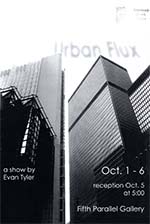installations
Urban Flux
Notes
URBAN FLUX
The idea for this project began when I decided to explore the ruins of a motel in the process of demolition in south Regina. I grew up in south Regina, and I began to contemplate the changes in the landscape of this urban setting and beyond. Throughout the summer, I had a chance to form some ideas about the transience of the physical world we live in, and this led me on a journey to explore urban landscapes, specifically buildings that were in the process of demolition, construction, and sometimes I came across buildings that had been abandoned to deteriorate with time.
I loaded up my camera equipment and set out to explore a variety of urban centers. My travels this summer took me to Toronto, Saskatoon, Edmonton and Vancouver. I discovered that what is a common sight is the presence of construction sites, most notably defined by the cranes that arch against the sky, as well as demolition equipment and building materials – the lumber and cement – assembled for construction. I call this trend “urban flux” – a continuous change in the architectural structures of modern cities and which is evident by the ever-changing skylines.
We think of buildings as permanent structures that facilitate our lifestyles, for example homes to live in, schools, churches, markets and so on. From the earliest civilization of post and lintel style using wood and stone material, one can view the changing form and function of buildings through time and space. What is apparent is that because our developing technological world together with modern building materials, structures can be built more quickly than ever. Modern materials are light and easily assembled utilizing the demands for more buildings to accommodate the needs of our present world as we move toward the future. One can contrast this to the castles and cathedrals of the 16th century and the length of time, labor and effort required to build them with the concept of stability and permanence these ominous structures represented.
As this project began to take form, I uncovered other offshoots of our modern urban environment such as poor urban planning, mass production of homes and malls, and the demolition of historical landmarks. There is a trend to mass produce whole suburban areas with homes that duplicate each other in form and color. I visited the Vancouver Art Gallery which featured the architecture of Arthur Erickson. His philosophy is to build in a way that is harmonious with nature and the surrounding natural environment. While thinking on this, I thought about the role of the artist and I came to understand that it is to look for and create reasonable solutions and ideas for how people can live in harmony with their environments with a vision to revitalize city life, rather than destroy it.
The photographs and videos presented in this work feature the images of the urban skyline. I wanted to illustrate the essence of a building, which is its form and function, as well as its temporary existence as a solid foundation to its inevitable demolition or abandonment. Both states of construction and demolition will be represented by two types of mediums: photography and video. The photographs represent the life of the building where it serves its purpose as a standing form. These still photographs suggest a still frame in time, which may not be relevant over a larger period of time as the buildings are subject to change or demolition. The choice of black and white photography suggests the duality of life and death. Life is suggested when the building is functional, and although its form may be subject to change and alteration, it remains noticeable as a functional structure. Death is when a building is demolished.
The motel in Regina was still partly in use, and one of the video clips you will view captures a clear hallway transition from functional use to non-functional use. I realized that by building this installation that is representative of these ideas, I was engaging in the very process I am observing, for one day, my structure will no longer stand as a solid, still form, and will meet its destiny in ruins.
The televisions in this installation feature videos that capture buildings in construction and demolition which represent “flux”. The footage represents a moving voyeurism of once functional structures in the process of demolition, or conversely in the process of construction as new buildings are being built.
The intention of this work is to encourage the audience to develop some awareness of the direction that we are moving toward in our modern world. As well, the viewer can reflect on his or her own views about city life and the buildings that we live and work in. There is an opportunity to add to these ideas in a world of “urban flux”.



